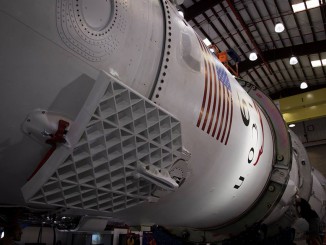
The last of Japan’s first series of HTV supply ships departed the International Space Station on Tuesday with several tons of trash, old batteries, and unneeded equipment, heading for a destructive re-entry before the debut of an upgraded cargo freighter design.
The HTV cargo ship was released from the space station’s Canadian-built robotic arm at 1:36 p.m. EDT (1736 GMT) to wrap up an 85-day stay at the orbiting research outpost.
Astronauts closed the hatches between the HTV and the station’s Harmony module Monday in preparation for the spacecraft’s departure. Ground teams then planned to use the robotic arm to detach the HTV from its space station berthing port and maneuver it to a location roughly 30 feet, or 9 meters, below the complex.
Space station commander Chris Cassidy sent the command for the robotic arm to release the HTV Tuesday. Russian cosmonaut Ivan Vagner assisted Cassidy at a robotics work station in the space station’s windowed cupola module.
The HTV fired thrusters to depart the vicinity of the space station, setting up for a sequence of burns to re-enter the atmosphere around 3:07 a.m. EDT (0707 GMT) Thursday. Serving as a trash disposal vehicle, the spacecraft will burn up on re-entry targeted to occur over the South Pacific Ocean.
Japan’s ninth HTV supply carrier arrived at the station May 25, five days after launch from the Tanegashima Space Center aboard a Japanese H-2B rocket. The HTV 9 mission delivered more than 13,600 pounds, or 6.2 metric tons, of cargo, supplies and experiments in its pressurized module and on its external payload bay, according to the Japan Aerospace Exploration Agency, or JAXA.
The barrel-shaped H-2 Transfer Vehicle is nicknamed Kounotori, which is Japanese for “white stork,” and stretches around 33 feet (10 meters) long and 14 feet (4.4 meters) wide.
The HTV 9 mission carried six new lithium-ion batteries to the station inside its unpressurized cargo compartment. NASA astronauts Chris Cassidy and Bob Behnken installed the upgraded batteries on the space station’s solar power truss, completing a multi-year upgrade to the research lab’s electrical system.
A cargo pallet loaded with eight obsolete nickel-hydrogen batteries was robotically installed into the HTV 9 spacecraft for disposal. Astronauts also placed a no-longer-needed resupply rack and a European stowage rack into the HTV ahead of its departure from the space station Tuesday.
The last set of disused nickel-hydrogen batteries will be jettisoned from the space station by its robotic arm later this year to naturally fall out of orbit due to aerodynamic drag.
“It’s been a real honor for the members of Expedition 63 … to welcome HTV, conduct operations in it, and now to be part of its departure on the ninth spaceship of the class,” Cassidy said after the departure of the HTV 9 mission. “Much congratulations to our colleagues and friends at JAXA.”

The HTV 9 mission marks the final flight of Japan’s current HTV spacecraft design, which first reached the space station in 2009. The Japan Aerospace Exploration Agency is developing an upgraded cargo vehicle named the HTV-X, which is slated to fly to the space station for the first time in 2022.
“HTV is the last Japanese cargo vehicle of the series, yet this final departure is the beginning of a new chapter for (JAXA), which is developing a next-generation cargo vehicle HTV-X,” said Japanese astronaut Norishige Kanai, who served as spacecraft communicator at NASA’s mission control center in Houston for Tuesday’s operations. “With the upgraded capability of the new vehicle, we will extend our activity in space, not only on ISS, but beyond low Earth orbit. We look forward to seeing HTV-X in the near future. Until then, farewell HTV. Arigato (and) sayonara, Kounotori.”
Unlike the HTV, which is grappled by the robotic arm and berthed with the space station, Japan’s HTV-X is designed to directly dock with the orbiting outpost, using the same docking ports as SpaceX’s Crew Dragon and Boeing’s Starliner crew capsules.
JAXA provides resupply services to the space station to help pay for Japan’s share of the the research lab’s operating costs. In addition to space station missions in low Earth orbit, Japanese officials say the HTV-X spacecraft could haul logistics to the future Gateway mini-space station near the moon.
Japan’s H-2B launcher was also retired with the final HTV flight. The HTV-X missions will launch on Japan’s next-generation H3 rocket.
The HTV-X could also resupply more distant outposts than the International Space Station, such as the planned Gateway mini-space station in orbit around the moon.
Other equipment delivered to the station in May by Japan’s HTV 9 mission included a module to support a Japanese combustion experiment, a camera from a Spanish company that will be tested to gauge its usefulness on small satellites and CubeSats, new science racks for to the space station NASA and the European Space Agency, plus a water tank and fresh food for the research lab’s crew.
Email the author.
Follow Stephen Clark on Twitter: @StephenClark1.



